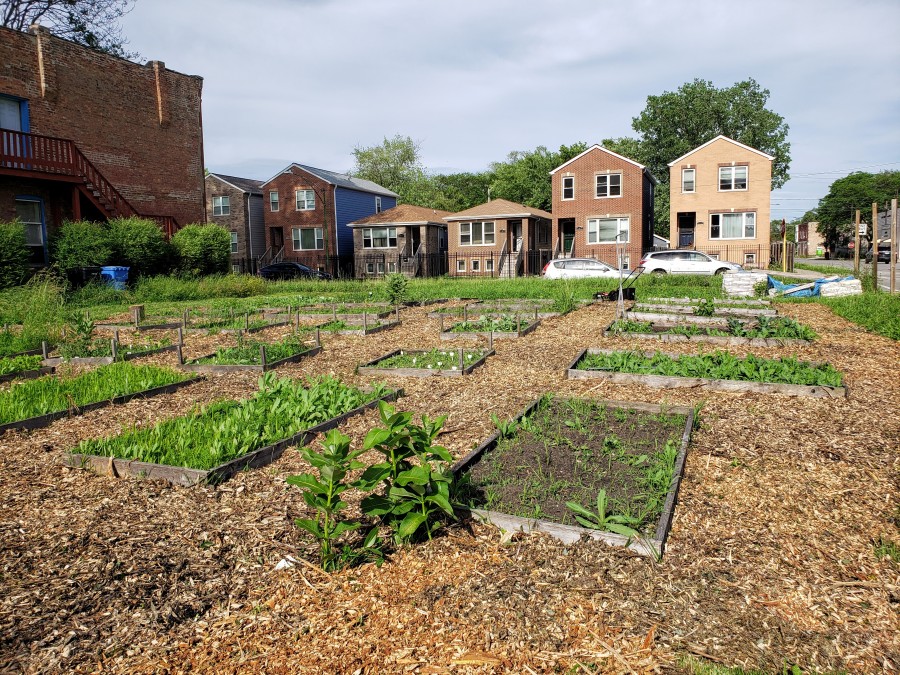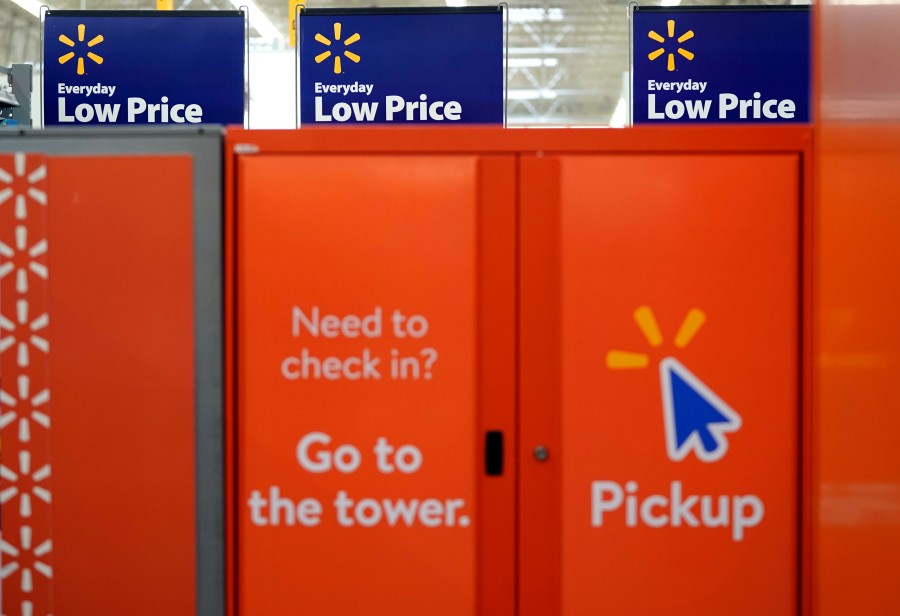
Big-box supermarkets and small local farmers struggle to make the marriage work
The idea – distribute homegrown produce through the power of national chain stores – was a good one. Here’s why some efforts in Chicago fell apart.
By Sandra GuyNine years ago, the woman- and Black-owned Urban Growers Collective secured a great deal selling produce from a Bridgeport farm to Walgreens.
At the time, the Deerfield-based drugstore giant was at the vanguard of stores touting expanded fresh food, fruits and vegetable sections in its aisles – particularly in neighborhoods that are considered “food deserts” without access to supermarkets.
The Austin, Texas-based retailer Whole Foods used that playbook, too, promoting its purchasing from small, Midwest farms when it opened a store six years ago with much fanfare in Englewood on the city’s South Side. Even Walmart crowed about locally grown cantaloupes and corn when it opened a supercenter in Chicago’s Austin neighborhood.
The idea, of course, was to boost availability of healthy, local produce in neighborhoods where it was scarce, all the while supporting the region’s agricultural ecosystem.

Now, the Whole Foods in Englewood is on the brink of closing, and there’s scant signs of local produce in area Walgreens and Walmart stores. Such ambitious plans to connect big grocers to small farmers appear to have fallen apart. But why? And what happened to the farms?
In the case of Walgreens, the partnership with the Urban Growers Collective and other local farms ended after 15 months because the costs proved too high to weave small agricultural operations into a massive supply chain. The drive to grow produce at a volume required to sell to big stores, in many cases, left local farmers in the lurch because they were unable to scale up quickly enough to meet that demand.
Government red tape and hard-to-meet regulations added to the burden.
Consumer demand also started to shift. People love farmers’ markets, but at the grocer, value and efficiency seem to dominate decision-making.
“The more the grocery industry shifts to buy online and delivery, the less likely the consumer will be interested in the origin of those products,” said Steve Tracey, professor of practice and the executive director for the Center for Supply Chain Research at Penn State University.

Long before unchecked inflation put food sellers in the hot seat, the mass market grocery industry had entered an all-out price war. Delivering the best prices on, say, a pound of tomatoes put stores through a pattern of scaling up, buying in bulk for efficiency and pursuing mergers and consolidations — the latest being a proposed $24.6 billion deal to marry Kroger-owned Mariano’s and Albertsons-owned Jewel. (Representatives from Kroger did not respond to questions about how the merger would impact the local food ecosystem.)
These supermarket trends have made it less likely to find local produce in big box stores. Farmers, as a result, have had to pivot. And some successfully have.
Supply chain struggles
Eleven years ago, when the Walmart supercenter opened in Austin, shoppers flocked to a bright entrance filled with seedless watermelon priced at $3.48 per pound and locally grown cantaloupes for $1.68 each. Baskets of unshucked corn included signs identifying the local farm where the products were grown.
A recent visit to that store revealed no produce that could be traced to a local Chicago grower. Representatives from Walmart did not respond to requests for comment.
It’s a classic example of how such pledges can fall apart. That’s because of the huge volumes of food required to stock such stores and food-safety regulations that can make supply chain logistics overwhelming for small businesses to navigate, said Tracey, of Penn State University.

Less than 2% of U.S. produce comes from small artisanal, or family farms, and they couldn’t possibly fulfill major chains’ supply chain needs, said Tracey.
The Urban Growers Collective, for example, was providing Walgreens with 60 to 70 products each week, such as cherry tomatoes and snap peas but ran into trouble because the collective moved its certified farm from one location to another.
That meant each farm in the collective had to qualify for the Good Agricultural Practices (GAP) certification, spend time on paperwork and meet standards such as soil and water testing, maintaining separate produce washing stations and even requiring visitors not to chew gum or wear jewelry for food safety, said Laurell Sims, co-founder and CEO of finance for Urban Growers Collective.
“We follow these food safety standards at each site, but it’s a heavy lift and expensive for a small urban farmer to certify every new site,” said Sims.
In addition, meeting a major retailer’s large produce volume requirements would have meant planning the planting a year in advance, she said. The collective’s farms cover a total of 11 acres in sites as diverse as Grant Park, South Chicago, Jackson Park, Altgeld Gardens and Roosevelt Square on the Near West Side.

After the Walgreens deal dissolved, Urban Growers Collective launched a mobile farmers’ market in a retrofitted bus that makes 15 stops a week, Monday through Friday, at schools, community centers and health centers. The collective also sells produce to neighborhood markets, church farm stands and restaurants.
Now, said Sims, “We can keep produce grown at our farms in the communities from which it is grown.”
Not all big box retailers have given up on local produce sourcing. Whole Foods, owned by Amazon, still sources products from local farmers and small-scale food start-ups.
The Austin, Texas-based retailer features 30% more locally sourced products in its stores today than it did five years ago and provides loans to suppliers through its Local Producer Loan Program, said Rachel Malish, Whole Foods’ global public relations spokesperson, in an emailed response to questions.
“We have a good amount of seasonal local produce in our Midwest stores right now like kale, hard squash, apples, carving pumpkins, mums, etc.,” Malish said.
Such offerings may be available in River North and the West Loop, but they won’t be available in Englewood after that store closes next week. It’s not the only supermarket that has recently shuttered stores in low-income Chicago neighborhoods. In June, the German supermarket chain Aldi abruptly closed a store in the Auburn Gresham neighborhood with little warning, citing repeated burglaries and a downturn in sales.

Such closures have prompted ire among local food advocates, since supermarkets often make big promises when they enter new neighborhoods, everything from fixing the food desert problem to pledging support for local farmers.
No one ever seems to get the full story of why they abruptly close, said Elizabeth “Liz” Abunaw, founder and owner of Forty Acres Fresh Market, which will open a storefront in the Austin community next year.
“It’s an easy narrative to say the community didn’t support the store,” she said. “I don’t know that it’s a complete narrative. We typically don’t get that [complete story].”
Planning their pivot
Ultimately, local farmers say the problem won’t be solved by working with supermarket chains. Instead, they are looking for alternative ways to get nutritious produce to communities that need it.

In south suburban Mokena, Derek Drake is going directly to customers with a farm he started in an old shipping container. Using large-scale hydroponics, he farms year-round and sells his herbs, lettuces and cabbages online via Market Wagon, an Indianapolis-based e-commerce platform.
Shoppers who pay Market Wagon’s flat $6.95 delivery fee receive cold-packed totes with produce grown on Drake’s farm, which he calls Ditto Foods. Most of the veggies are grown in a 40-foot shipping container on Drake’s Mokena property that can yield as much as 3 acres of produce. The produce are nourished with nutrient-rich water using no soil. The system recycles water and air moisture, so it uses less than 5 gallons of water a day.
“I wanted to do ‘tiny home meets food truck,’” Drake said. “You can put [the container] in neighborhoods and create a new, innovative food delivery system.”
Ditto Foods also sells produce to small grocery stores and restaurants, filling a niche with freshly farmed food.
Drake and his co-owner and husband, Brad Schiever, chose the temperature-controlled, pesticide-free farming method as what he calls “a love letter” to his hometown, south suburban Ford Heights, a community plagued by long-term disinvestment.
“The narrative will be about a company that’s investing and forging ahead with a new and innovative way of growing produce,” Drake said, noting that he intends to expand to three hydroponic farms in the next five years.
Another hydroponic farmer, Terrence Glenn, owner of Chicago-based Urban Eden Farms, started his farm in a 400-square-foot space in The Plant, a Back of the Yards incubator dedicated to housing small food businesses. He is now up to 2,600 square feet of mushrooms, microgreens, lettuce greens, culinary herbs and edible flowers that he sells directly to food co-ops, small grocers and restaurants, the latter through two food distributors that take a 25% cut.
Glenn said he’s considering partnering with a U.K. firm aiming to open in Chicago and elsewhere in America to buy fresh food, store and sell it, and deliver it on e-bikes. The “marketing and sales are difficult” as a sustainable farmer, he added. “I have to be careful because the majority of my time is spent in operations.”

In the Austin neighborhood, Abunaw, of Forty Acres, said she has been challenged and exhilarated by solving the puzzle of how to bring freshly farmed local foods to an under-resourced neighborhood. Inflation has been hard on residents in Austin, particularly the elderly. So she’s been providing coupons to older people, courtesy of a state nutrition program, so they can buy fresh, healthy food.
“The community of Austin has welcomed Forty Acres,” Abunaw said. “That keeps you going. Ultimately, I said this is a customer worth servicing. There’s a perception, there’s no money to be made out there. It’s not worth the effort. I reject that wholeheartedly.”
Natasha Nicholes, who with her husband, Shomari, run two urban farms in Chicago’s West Pullman neighborhood, is still figuring out her business model. Three years ago, the Nicholeses created a non-profit, educational farm called We Sow We Grow.
They’ve expanded with the help of volunteers, grants, and donations. In June, they leased four additional lots — a quarter-acre of land kitty-corner at the same intersection from their initial site — so they can grow seasonal vegetables. The long-range vision is to sell the produce to people who pick up the produce weekly.
“We’re trying to make vegetables and fruits fun,” said Natasha. But her growth plan, wherever it takes her, will be rooted in independence. She said she has “no desire to do mass production.”
“It takes the fun out of it for me.”
Sandra Guy is a freelance writer in Chicago.

